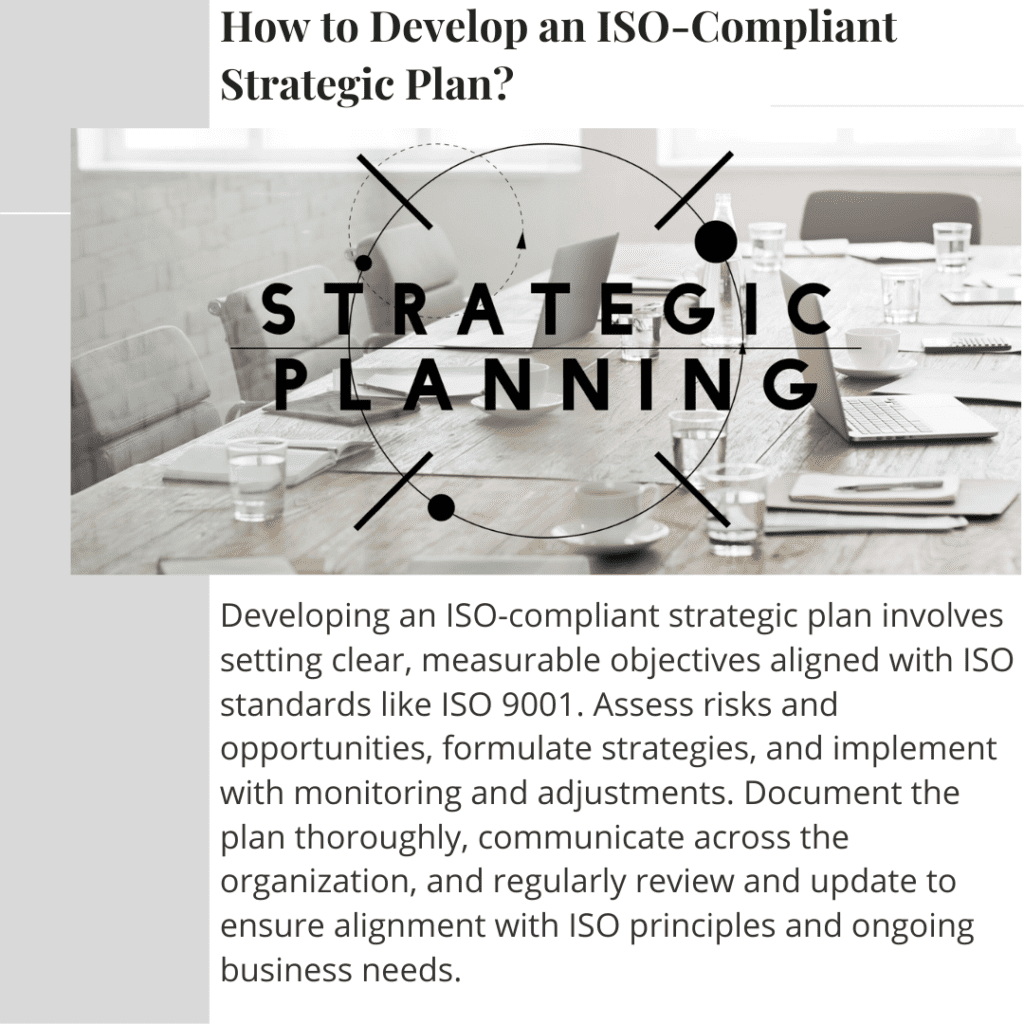Subtotal $0.00

Developing an ISO-compliant strategic plan involves aligning organizational objectives with ISO standards to ensure systematic implementation, continuous improvement, and adherence to quality management principles. Here’s a comprehensive guide on how to develop an ISO-compliant strategic plan, incorporating relevant keywords such as courses, certification, quality systems, and more.
How to Develop an ISO-Compliant Strategic Plan
ISO standards provide frameworks for organizations to establish robust management systems that align with strategic objectives, enhance efficiency, and ensure compliance with international best practices. Developing an ISO-compliant strategic plan involves integrating quality management principles, risk assessment, stakeholder engagement, and continuous improvement initiatives into the organization’s overall strategy.
Understanding ISO Standards in Strategic Planning
ISO (International Organization for Standardization) standards, such as ISO 9001 (Quality Management Systems), ISO 14001 (Environmental Management Systems), and ISO 45001 (Occupational Health and Safety Management Systems), provide guidelines for organizations to implement effective management systems. These standards promote a structured approach to achieving organizational goals while maintaining focus on customer satisfaction, risk management, and continuous improvement.
Key Steps to Develop an ISO-Compliant Strategic Plan
1. Context Analysis and Leadership Commitment
Internal and External Context: Conduct a thorough analysis of internal strengths, weaknesses, opportunities, and threats (SWOT analysis) and external factors (PESTLE analysis) that impact the organization.
Leadership Commitment: Secure commitment from top management to align strategic objectives with ISO standards and allocate necessary resources for implementation.
2. Setting Strategic Objectives
SMART Goals: Define Specific, Measurable, Achievable, Relevant, and Time-bound (SMART) objectives that align with ISO standards and organizational priorities.
Quality Objectives: Establish quality objectives that support the organization’s mission and vision, emphasizing continuous improvement and customer satisfaction.
3. Risk Assessment and Mitigation
Risk Identification: Identify and assess risks associated with achieving strategic objectives, considering internal processes, external influences, and compliance with ISO standards.
Risk Management Plan: Develop a risk management plan to mitigate identified risks, incorporating preventive and corrective actions to enhance resilience and sustainability.
4. Resource Allocation and Implementation
Resource Planning: Allocate human, financial, and technological resources required to implement strategic initiatives aligned with ISO standards.
Project Management: Use project management methodologies to monitor progress, track key performance indicators (KPIs), and ensure timely completion of strategic objectives.
5. Monitoring and Evaluation
Performance Metrics: Define performance metrics and indicators to measure progress towards strategic goals and compliance with ISO standards.
Internal Audits: Conduct regular internal audits to assess the effectiveness of implemented processes, identify areas for improvement, and ensure adherence to ISO requirements.
Benefits of Developing an ISO-Compliant Strategic Plan
Enhanced Efficiency: Streamlines operations and resource utilization, improving overall efficiency and productivity.
Risk Mitigation: Identifies and addresses potential risks proactively, minimizing disruptions and enhancing organizational resilience.
Continuous Improvement: Promotes a culture of continuous improvement based on ISO principles, fostering innovation and responsiveness to changing market dynamics.
Stakeholder Confidence: Builds trust and confidence among stakeholders, customers, and partners by demonstrating commitment to quality, compliance, and sustainable practices.
Training and Certification for ISO-Compliant Strategic Planning
To effectively develop and implement an ISO-compliant strategic plan, invest in relevant training and certification programs:
Internal Auditor Training: Equip internal auditors with skills to assess compliance with ISO standards, conduct audits, and identify opportunities for improvement.
Lead Auditor Training: Develop lead auditors capable of managing ISO certification audits and driving continuous improvement initiatives within the organization.
Online Courses and Qualification Programs: Provide accessible online courses that deepen employees’ understanding of ISO standards, strategic planning methodologies, and quality management principles.
Conclusion
Developing an ISO-compliant strategic plan involves aligning organizational goals with ISO standards to ensure systematic implementation, continuous improvement, and adherence to quality management principles. By integrating ISO standards into strategic planning processes, organizations can enhance efficiency, mitigate risks, and achieve sustainable growth while demonstrating commitment to quality, compliance, and stakeholder satisfaction. Leveraging ISO certification not only enhances organizational performance but also positions the organization as a leader in its industry, driving long-term success and competitiveness in global markets.